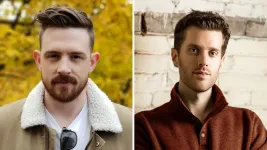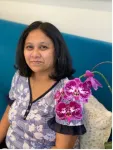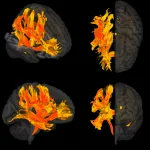(Press-News.org) Every year, millions of birds crash into windows in cities along their migratory path. For decades, scientists and volunteers have risen at dawn in spring and fall to collect the fallen birds, rehabilitating the injured and documenting the dead. The bodies of the birds killed in these collisions are a treasure trove of scientific information, especially when compared year after year. A new study in the journal Molecular Ecology makes use of these specimens to help understand the relationship between birds and the microbes living in their guts—which appears to be wildly different from mammals and their microbiomes. The scientists’ work involved DNA sequencing, and a whole lot of bird poop.
“In humans, the gut microbiome—the collection of bacteria, fungi, and other microbes living in our digestive tracts—is incredibly important to our general health and can even influence our behavior. But scientists are still trying to figure out how significant a role the microbiome has with birds,” says Heather Skeen, a research associate at the Field Museum who completed her PhD through the Field and the University of Chicago.
Scientists have found that in our fellow mammals, different species tend to have their own signature array of gut microbes that help them digest food and fight off disease. DNA studies have even shown that these relationships can go back millions of years, with different mammals co-evolving with their microbiomes in a symbiotic relationship that benefits both the mammal and its microbes. But researchers like Skeen have been finding that birds’ microbiomes likely play by a different set of rules.
“Bird gut microbiomes don’t seem to be as closely tied to host species, so we want to know what does influence them,” says Skeen. “The goal of this study was to see if bird microbiomes are consistent, or if they change over short time periods.”
While dozens of species arrive at the Field Museum after crashing into Chicago’s buildings, Skeen focused on four common species of songbirds called thrushes, in order to ensure a large sample size. To study the thrushes’ gut microbiomes, Skeen went right to the source. “You make a small incision into the abdomen to reach the intestines, and then you squeeze out the contents,” says Skeen. Overall, she took samples from 747 birds over the course of 3 years, supplementing the Chicago birds with additional samples taken from thrushes in their summer breeding ground in Michigan, Minnesota, and Manitoba.
After transferring the bird poop from their intestines to specialized filter paper cards that preserve DNA, the researchers sent the genetic material off for bacteria classification.
“Analyzing the bacterial DNA present in the poop allowed us to determine exactly what kinds of bacteria were present,” says Skeen. “It turns out, there were about 27,000 different types of bacteria present.”
Skeen and her colleagues looked for trends in the bacteria present across the 747 birds in the sample. They found that, unlike in mammals, the different bird species didn’t seem to have their own unique set of microbes. Instead, the clearest link between the birds and the bacteria in their microbiomes was time: season to season, year to year, the birds’ gut microbes changed.
“Across the years, there were fairly significant differences in the composition of the bacteria, which was surprising,” says Skeen.
These findings point to birds’ microbiomes likely having more to do with the environment around them than the inborn, consistent relationship seen in most mammals.
“Heather’s research is blowing people’s minds about what a microbiome is or isn’t,” says Shannon Hackett, associate curator of birds at the Field and a co-author of the paper. “How do birds have functioning immune systems, if their microbiomes change so much in just a few months? It’s hard to weave that into a consistent theory about how they digest food, how they reject parasites, all the things we think of the microbiome doing in humans. How does that work?”
Hackett also says that the study helps illustrate the value of museum collections. Study co-author and Field collections manager emeritus Dave Willard began picking up birds killed by nearby Chicago buildings forty years ago, she notes.
“At the time, people were like, ‘What the hell are you doing?’ But the fact that he’s been doing this for forty years means we have a unique opportunity to study birds across fairly short periods of time. We have more than 100,000 window-killed birds at this point, it’s an incredibly rich resource,” says Hackett. “And as technology evolves and new scientists like Heather come up, we broaden what we’re able to do with these resources.”
###
END
Understanding of and trust in science and scientists are dangerously low, and initial studies suggest that a general lack of interest in science is even more of a problem than skepticism in Austria. A key partner in alleviating this mistrust, clearing up misunderstandings, and building up enthusiasm for science must be the media in general and science journalists in particular. However, these journalists need access to the information as well as the resources to work independently and give full flight to their curiosity and creativity. To work towards these goals and promote excellent science journalism, ISTA initiated a program to host journalists for two-to-four-month ...
Malignant melanoma is a relatively aggressive type of skin cancer. When detected early, it is usually treatable by surgical resection only, but metastases develop often spreading to distant areas. Currently, tumor thickness and the presence of ulceration are some of the known prognostic factors used as indicators of malignant melanoma. Therefore, the discovery of valuable markers to assess the malignant potential of melanoma more accurately may be necessary to develop appropriate treatments.
Cross talk between cancer cells and surrounding stromal cells is ...
For the first time, researchers have developed a form of the omega-3 fatty acid docosahexaenoic acid (DHA) that is capable of crossing into the eye’s retina to ward off visual declines related to Alzheimer’s disease, diabetes and other disorders.
The DHA found in fish oil capsules and other supplements is typically in a form called triacylglycerol (TAG) DHA. Although TAG-DHA has benefits in other parts of the body, it does not reach the eyes because it cannot travel from the bloodstream into the retina. For the study, ...
The lower prevalence of ‘risky’ sex—with multiple or new partners without using condoms—which occurred during the early stages of the COVID-19 pandemic, was still evident a year after Britain’s first lockdown, reveal the results of a major national survey, published online in the journal Sexually Transmitted Infections.
While there were fewer reported unplanned pregnancies and abortions than indicated by a comparable survey a decade earlier, there were significantly higher prevailing levels of sexual dissatisfaction and worries ...
People with atopic (allergic) diseases like asthma or eczema may be at heightened risk of the painful and often disabling joint condition, osteoarthritis, finds research published online in the Annals of the Rheumatic Diseases.
Drugs used to dampen down the physiological prompts for allergic reactions in the body may help lessen this risk, suggest the researchers.
Osteoarthritis is the most common form of arthritis. But despite the high prevalence, substantial costs, and debilitating impact of the disease, there is as yet no effective ...
Engaging communities in developing a real-time early warning system could help to reduce the often-devastating impact of flooding on people and property – particularly in mountainous regions where extreme water events are a ‘wicked’ problem, a new study reveals
Flash floods are becoming more frequent and damaging to the lives and property of vulnerable people, but researchers believe that using a SMART approach to engage with those living in such areas will help to better signal impending risk from flooding.
Scientists believe that combining meteorological data with information on how people live and work in such regions, will help disaster risk ...
For the first time, researchers have identified specific regions of the brain that are damaged by high blood pressure and may contribute to a decline in mental processes and the development of dementia.
High blood pressure is known to be involved in causing dementia and damage to brain function. The study, which is published in the European Heart Journal [1] today (Tuesday), shows how this happens. It gathered information from a combination of magnetic resonance imaging (MRI) of brains, genetic analyses and observational data from thousands of patients to look at the effect of high blood pressure on cognitive function. The researchers then checked their findings ...
Growing concerns over the potential health effects of exposure to phthalates, a component of many plastics and also known as a plasticizer, have led to a search for safer alternatives. In a new study conducted in cell cultures, researchers found that the chemical acetyl tributyl citrate (ATBC) might not be the best replacement because it appears to interfere with the growth and maintenance of neurons.
“In the past, industries have promptly shifted away from the usage of toxic chemicals only to produce an equally toxic chemical, so this is something we are actively trying to avoid repeating,” said Kyle Sease, a graduate student at Central Washington ...
A new study found that people who are currently suffering or face a high risk of post-traumatic stress disorder show particular patterns in four biomarkers measurable with a simple blood test. The findings suggest these biomarkers could be used to predict a person’s likelihood of developing PTSD, diagnose the disorder or monitor the response to treatment.
PTSD can occur after experiencing or witnessing a traumatic event. It is currently diagnosed based on symptoms such as flashbacks, difficulty sleeping or concentrating, ...
M1 and M2 are activated macrophages that protect our immune system and maintain homeostasis. Interestingly, they are characterized by distinct and opposing phenotypes. M1 macrophages are known for their bactericidal and tumoricidal properties by secreting pro-inflammatory cytokines, while M2 macrophages facilitate immunosuppressive responses and help cancer progression. As such, reprogramming macrophages from M2 to M1 phenotype has been regarded as a significant interest in the view of potential cancer ...







